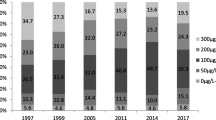Abstract
Both Shanghai and Switzerland are developed regions with long-standing salt iodization programs and periodic monitoring. However, the two regions have their own approach to the implementation of the iodized salt policy. In Shanghai, monitoring was carried out every few years, using probability-proportional-to-size sampling technique to select 30 sampling units. Each unit consisted of more than 12 pregnant women and one randomly selected primary school. Urine samples were then taken from the chosen pregnant women and randomly recruited students of that school for iodine test. Data of Switzerland used in this comparative study was extracted from published researches. In Shanghai, the median urinary iodine concentration (UIC) in 2014 was 20% lower than in 1999 (P < 0.05). The median UIC of pregnant women in 2014 was 9.5% lower than that in 2011 (P < 0.05). In terms of iodized salt concentration, opposite to the increasing in Switzerland, it has exhibited a downward trend in Shanghai (P < 0.05). For the years monitored, the iodized salt concentration in Shanghai was significantly (P < 0.05) higher than in Switzerland. Though the UIC of children exhibited a downward trend in Shanghai (P < 0.05), it was still significantly (P < 0.05) higher than in Switzerland over the same monitoring period. However, the UIC in pregnant women was a totally different story, which was significantly (P < 0.05) lower in Shanghai than in Switzerland. Iodized salt is very important for maintaining sufficient iodine level in the population. Appropriate concentration of iodine in fortified salt needs to be decided according to local conditions. Special attention should be paid to the iodine level of pregnant women in Shanghai, and more education about iodine is necessary for the public health.


Similar content being viewed by others
References
Abd El Naser Yamamah G, Kamel AF, Abd-El Dayem S, Hussein AS, Salama H (2013) Thyroid volumes and iodine status in Egyptian South Sinai schoolchildren. Arch Med Sci 9:548–554
Zimmermann MB (2009) Iodine deficiency. Endocr Rev 30:376–408
Auso E, Lavado-Autric R, Cuevas E, Del Rey FE, Morreale De Escobar G et al (2004) A moderate and transient deficiency of maternal thyroid function at the beginning of fetal neocorticogenesis alters neuronal migration. Endocrinology 145:4037–4047
WHO/UNICEF/ICCIDD (2007) Assessment of Iodine Deficiency Disorders and Monitoring Their Elimination: A Guide for Programme Managers, 3rd edn. World Health Organization, Geneva
Andersson M, Karumbunathan V, Zimmermann MB (2012) Global iodine status in 2011 and trends over the past decade. J Nutr 142:744–750
Zimmermann MB, Andersson M (2012) Update on iodine status worldwide. Curr Opin Endocrinol Diabetes Obes 19:382–387
Wong EM, Sullivan KM, Perrine CG et al (2011) Comparison of median urinary iodine concentration as an indicator of iodine status among pregnant women, school-age children, and nonpregnant women. Food Nutr Bull 32:206–212
Federal Commission for Nutrition (2013) Iodine supply in Switzerland: Current Status and Recommendations. Expert report of the FCN. Federal Office of Public Health, Zurich. http://www.ign.org/cm_data/2013_Federal_Commission_for_Nutrition_Iodine_Report_2013.pdf. Accessed March 1, 2018
Haldimann M, Bochud M, Burnier M, Paccaud F, Dudler V (2015) Prevalence of iodine inadequacy in Switzerland assessed by the estimated average requirement cut-point method in relation to the impact of iodized salt. Public Health Nutr 18:1333–1342
Yan Y, Zhang Y, Liu L, Liu J, W L (2006) Method for determination of iodine in urine by As3+-Ce4+catalytic spectrophotometry (WS/T 107–2006). People’s Medical Publishing House, Beijing
Burnier M, Wuerzner G, Bochud M (2015) Salt, blood pressure and cardiovascular risk: what is the most adequate preventive strategy? A Swiss perspective. Front Physiol 6:227
Zou S, Wu F, Guo C, Song J, Huang C et al (2012) Iodine nutrition and the prevalence of thyroid disease after salt iodization: a cross-sectional survey in Shanghai, a coastal area in China. PLoS One 7:e40718
Hess SY, Zimmermann MB, Torresani T, Burgi H, Hurrell RF (2001) Monitoring the adequacy of salt iodization in Switzerland: a national study of school children and pregnant women. Eur J Clin Nutr 55:162–166
Zimmermann MB, Aeberli I, Torresani T, Burgi H (2005) Increasing the iodine concentration in the Swiss iodized salt program markedly improved iodine status in pregnant women and children: a 5-y prospective national study. Am J Clin Nutr 82:388–392
Andersson M, Aeberli I, Wust N, Piacenza AM, Bucher T et al (2010) The Swiss iodized salt program provides adequate iodine for school children and pregnant women, but weaning infants not receiving iodine-containing complementary foods as well as their mothers are iodine deficient. J Clin Endocrinol Metab 95:5217–5224
Lazarus JH (2014) Iodine status in Europe in 2014. Eur Thyroid J 3:3–6
Watutantrige Fernando S, Cavedon E, Nacamulli D, Pozza D, Ermolao A et al (2016) Iodine status from childhood to adulthood in females living in North-East Italy: Iodine deficiency is still an issue. Eur J Nutr 55:335–340
Erdogan MF, Agbaht K, Altunsu T, Ozbas S, Yucesan F et al (2009) Current iodine status in Turkey. J Endocrinol Investig 32:617–622
Vanderpump MP, Lazarus JH, Smyth PP, Laurberg P, Holder RL et al (2011) Iodine status of UK schoolgirls: a cross-sectional survey. Lancet 377:2007–2012
Bath SC, Walter A, Taylor A, Wright J, Rayman MP (2014) Iodine deficiency in pregnant women living in the South East of the UK: the influence of diet and nutritional supplements on iodine status. Br J Nutr 111:1622–1631
Bath SC, Rayman MP (2015) A review of the iodine status of UK pregnant women and its implications for the offspring. Environ Geochem Health 37:619–629
Okuda N, Stamler J, Brown IJ, Ueshima H, Miura K et al (2014) Individual efforts to reduce salt intake in China, Japan, UK, USA: what did people achieve? The INTERMAP Population Study. J Hypertens 32:2385–2392
James WP, Ralph A, Sanchez-Castillo CP (1987) The dominance of salt in manufactured food in the sodium intake of affluent societies. Lancet 1:426–429
Zimmermann MB, Aeberli I, Torresani T, Bu¨ rgi H. (2005) Increasing the iodine concentration in the Swiss iodized salt program markedly improved iodine status in pregnant women and children: a 5-y prospective national study. Am J Clin Nutr 82:388–392
Cui J (2012) Report on the use of iodized salt in China's food processing industry. China Salt Ind 6:11–14 (In Chinese)
Pearce EN, Caldwell KL (2016) Urinary iodine, thyroid function, and thyroglobulin as biomarkers of iodine Status. Am J Clin Nutr 104(Suppl 3):898S–901S
Zimmermann MB, Aeberli I, Andersson M, Assey V, Yorg JA et al (2013) Thyroglobulin is a sensitive measure of both deficient and excess iodine intakes in children and indicates no adverse effects on thyroid function in the UIC range of 100-299 mug/L: a UNICEF/ICCIDD study group report. J Clin Endocrinol Metab 98:1271–1280
Ma ZF, Skeaff SA (2014) Thyroglobulin as a biomarker of iodine deficiency: a review. Thyroid 24:1195–1209
Momcilovic B, Prejac J, Visnjevic V, Skalnaya MG, Mimica N et al (2014) Hair iodine for human iodine status assessment. Thyroid 24:1018–1026
WHO (2011) Guidelines for drinking-water quality - 4th ed. World Health Organization, Gutenberg
Acknowledgements
We thank all the children and pregnant women who participated in this study, the healthcare professionals from the Centers for Disease Control and Prevention of the 17 districts in Shanghai.
Funding
The current study was supported by the National Nature Science Foundation of China (No. 81602851), Excellent Young Talents of Health System in Shanghai (No. 2017YQ043), the Fourth three year public health program (NO.GWIV-27.1), and Key Disciplines (No.15GWZK0801). None of the above funders played a role in the study design, data analysis or manuscript writing.
Author information
Authors and Affiliations
Contributions
Conceived and designed the experiments: Shoujun Liu, Xiaohui Su and Peng Liu; Performed the experiments: Shurong Zou, Jun Song and Zhengyuan Wang; Urine iodine and salt iodine test: Jun Song and Zhengyuan Wang; Analyzed the data: Zhengyuan Wang; Wrote the paper: Zhengyuan Wang and Shoujun Liu. All authors read and approved the final version of the manuscript.
Corresponding author
Ethics declarations
Competing Interests
The authors have no conflicts of interest relevant to this study.
Rights and permissions
About this article
Cite this article
Wang, Z., Liu, P., Su, X. et al. A Comparative Study of Iodized Salt Programs: Shanghai and Switzerland. Biol Trace Elem Res 187, 59–64 (2019). https://doi.org/10.1007/s12011-018-1370-6
Received:
Accepted:
Published:
Issue Date:
DOI: https://doi.org/10.1007/s12011-018-1370-6




